Last updated on March 9th, 2024 at 06:50 am
Are you looking to add a touch of elegance and vibrancy to your indoor space? Look no further than the Pink Princess Philodendron plant! With its stunning foliage and easy maintenance, this captivating plant is a popular choice among plant enthusiasts and beginners alike.
The highly desired Pink Philodendron is known as the pink princess and is scientifically known as Philodendron erubescens. This plant is distinguished by its lush, heart-shaped leaves that initially emerge as a rich, dark green, gradually transitioning into stunning hues of pink, red, or bronze as the plant matures. Its stems typically display a deep green color with a vibrant mix of bubblegum-pink, serving as an eye-catching addition to any room. Belonging to the Araceae family, it originates from the rainforests of South America.
Contents
Pink Philodendron Care
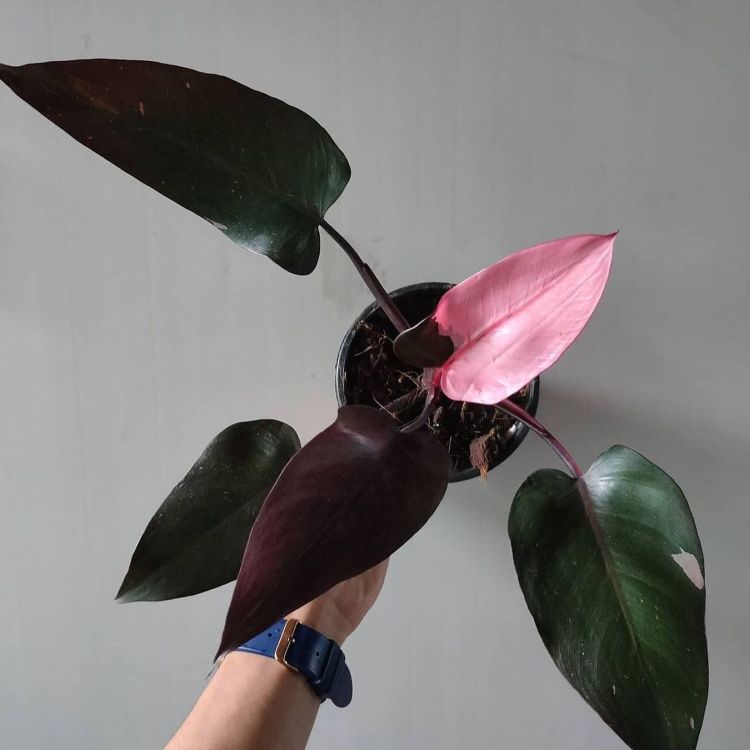
Image credit:philodendron_house_plant
This plant is cultivated indoors, yet it can flourish when placed outside in regions with warm, humid conditions. Given proper sunlight and attentive care, its foliage can expand significantly, reaching sizes of approximately 12 inches in both length and width, resulting in a striking and captivating appearance.
Pink Philodendron is beloved due to its low maintenance, here are some tips for the proper care of this beautiful plant.
Light Exposure
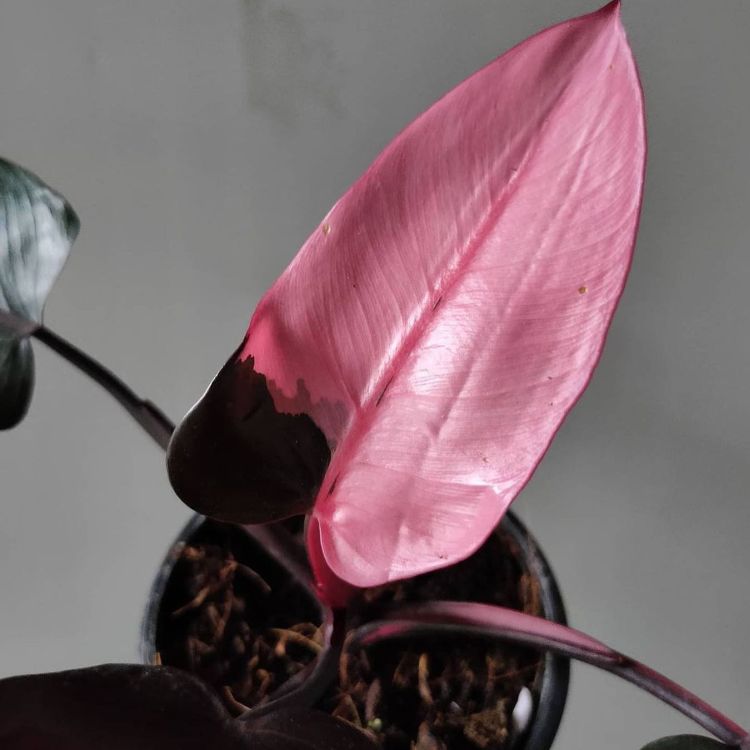
Image credit:philodendron_house_plant
Ensuring sufficient light is crucial to enhance the variegation of a pink philodendron. Opt for a location that receives 4 to 5 hours of bright, indirect sunlight. This plant can also tolerate a few hours of direct indoor light, which might accentuate its stunning patterns. However, if your home lacks ample natural light, considering a grow light is a wise choice to supplement its light needs.
Proper lighting plays a significant role in maintaining the vibrant colors and unique patterns of the pink philodendron’s leaves. Insufficient light may result in the leaves reverting to a uniform green color, losing their distinct and captivating variegation. Therefore, finding the right balance of light ensures the plant’s optimal growth and visual appeal.
Watering Tips
Allow the top half of the soil to dry out between watering sessions, then ensure a thorough watering for your pink princess philodendron. These plants are susceptible to root rot, so avoid letting them from sitting in overly wet soil.
It’s simpler to overwater the plant than to underwater it. If you’re uncertain about its water needs, it’s safer to wait an extra day before watering again.
Soil and Potting
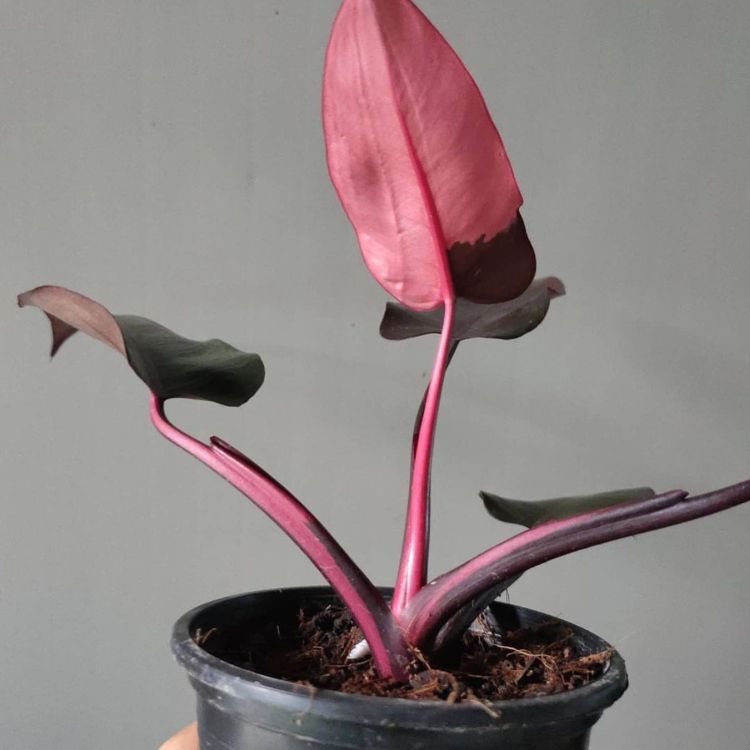
Image credit:philodendron_house_plant
It’s crucial to use nutrient-rich, well-draining soil that is light and has some porosity when cultivating the exquisite Philodendron Pink Princess. While many commercially available potting mixes are suitable for indoor plant growth (avoiding garden topsoil), it’s important to steer clear of soil mixes containing hydrogel crystals, as their moisture-retaining properties might contribute to root issues like rot when used indoors. Repot your plant when it outgrows its container, typically every 2-3 years.
Humidity and Temperature
Pink Philodendrons thrive in environments with high humidity and warmth, though typical household humidity levels and temperatures are usually suitable for these plants. To maintain optimal humidity, it’s beneficial to regularly mist the leaves or utilize a humidifier. These plants flourish best within temperatures ranging between 65-80°F (18-27°C), and it’s advisable to avoid exposing them to temperatures below 15°C.
Fertilizer
Feed your Pink Philodendron with a balanced liquid fertilizer during the growing season (spring and summer) to encourage healthy growth.
How To Propagate Pink Princess Philodendron
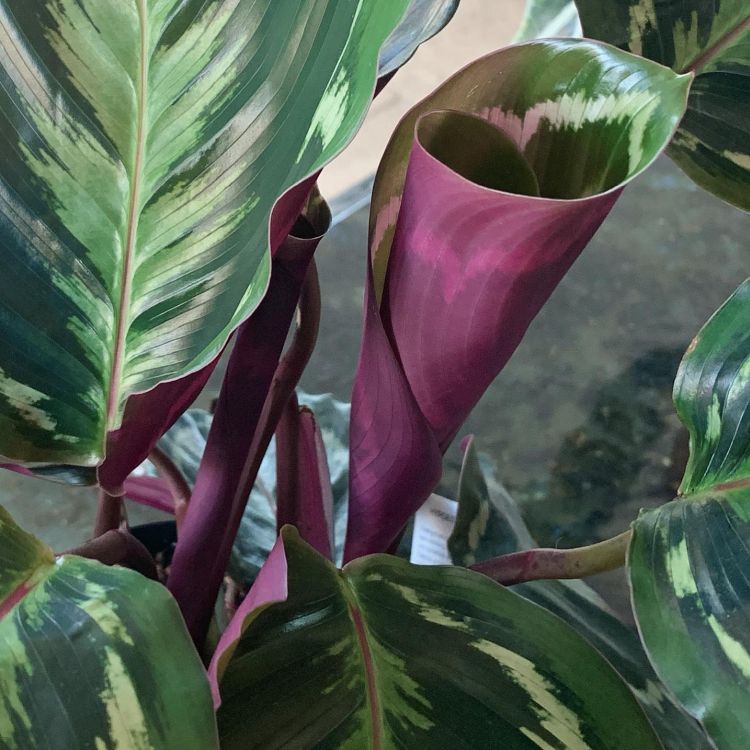
Image credit:pink_princess_philodendron
Propagating your Pink Princess Philodendron can be a rewarding and exciting journey, allowing you to expand your plant collection or share the beauty of this stunning plant with friends and family. There are two primary methods to propagate this plant: through stem cuttings in water or soil.
Stem Cuttings in Water
Start by choosing a healthy stem from the parent plant. Select a stem with at least two nodes (where leaves attach to the stem) and use clean scissors or pruning shears to make a clean cut just below a node, creating a cutting about 4-6 inches long. Ensure the cutting has a few leaves at the top.
Trim off a few lower leaves from the cutting, leaving at least one or two leaves at the top intact. For stem cuttings in water, place the cutting in a glass or jar of room temperature water, submerging only the nodes while keeping the leaves above the waterline. Change the water every few days, and after a few weeks, roots will start growing from the submerged nodes.
Stem Cuttings in Soil
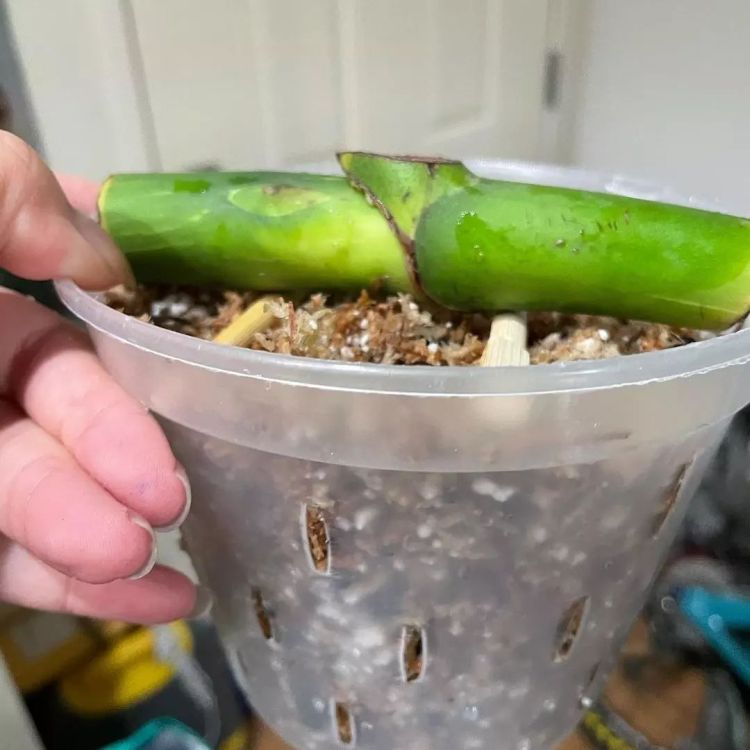
Image credit:variegated_houseplants_
For stem cuttings in soil, plant the cutting in a small pot filled with moist, well-draining potting mix. Ensure at least one node is buried in the soil. Keep the soil consistently moist but not waterlogged. Roots will gradually develop from the buried nodes over several weeks.
Once roots are well-established (usually after a few weeks), carefully transplant the cutting into a small pot with appropriate soil. Provide indirect light and maintain proper care to help the new plant establish itself.
Benefits of Pink Philodendron
Air Purification
Pink Philodendron helps to improve indoor air quality by removing toxins like formaldehyde from the air.
Stress Reduction
Pink Philodendron is linked to reducing stress and promoting a sense of well-being.
Easy to Propagate
It is very easy to propagate Pink Philodendrons through stem cuttings in water or soil, making it an excellent choice for gifting or expanding your plant collection.
Problems Of Pink Philodendron
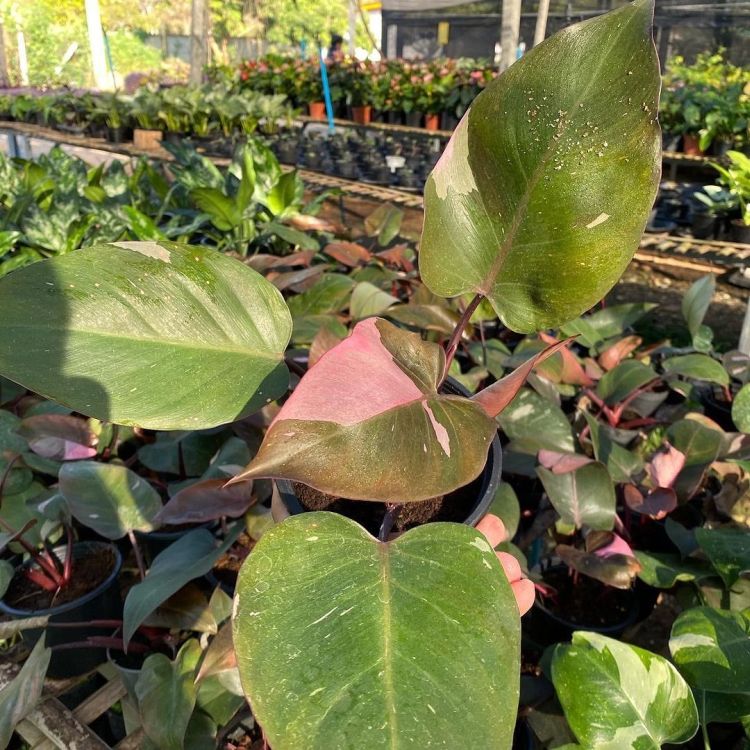
Image credit:philodendron_house_plant
Pink Princess Philodendrons are generally robust plants, but they can encounter a few issues. Here are some common problems that Pink Philodendron might face:
Leaves Are Losing Variegation
This issue commonly arises due to insufficient light exposure. Make sure your plant receives ample bright, indirect sunlight, and steer clear of dim or low-light settings to encourage vibrant variegation. It’s crucial to detect and address this concern early because a Pink Princess Philodendron that has completely lost its variegation won’t be able to regain it.
Leaves Turning Brown
Dry brown edges on the leaves of a pink princess philodendron usually happen when there’s not enough moisture in the air. Once the edges turn brown, you can’t fix them. However, boosting the humidity around the plant can prevent more browning in the future.
Leaves Losing Variegation
If Pink Princess Philodendron leaves are losing their pink color and variegation, it’s likely due to insufficient indirect light. To maintain their vibrant appearance, ensure the plant receives enough indirect sunlight as inadequate light can cause the leaves to revert to green. Adjust the plant’s placement for optimal light conditions to preserve its beautiful variegation.
Fungal Diseases
High humidity and poor air circulation can lead to fungal infections in your plants. If you notice spots or browning on the leaves, it might indicate a fungal disease. To prevent this, make sure there’s good airflow around your plant, avoid placing too many plants close together, and water your plant properly to lower the chance of fungal problems.
Pests
Pink Princess Philodendrons are usually resistant to pests but might attract common ones like spider mites, mealybugs, or aphids. Check your plant often for signs of pests, such as webs, tiny bugs, or sticky residue on leaves. If you find any, treat them quickly with insecticidal soap or neem oil.
Buying Pink Princess Philodendron
Why Pink Princess Philodendrons Are So Expensive?
Pink Princess Philodendrons have surged in popularity due to their mesmerizing foliage, creating a high demand that’s challenging for growers to meet. Their unique variegation, resulting from a genetic mutation, makes them difficult to propagate from seeds, contributing to their steep prices. However, as they’re becoming more mass-produced, the costs are gradually decreasing.
What to Consider When Making a Purchase?
When purchasing a Pink Princess Philodendron, focus on the foliage and stems. Seek consistent variegation across the leaves and examine the petioles for variegation too. Check for small brown spots on the leaves, as these plants are prone to fungal rust spot diseases.
How Much Do They Cost?
In their peak demand around 2021, mature Pink Princess Philodendrons fetched prices soaring above $2,000. Even single-leaf cuttings were being sold for hundreds of dollars on platforms like Etsy and Facebook Marketplace. Today, these plants are more accessible, with mature variegated ones priced around a few hundred dollars, while smaller plants or cuttings can be found for under $100 or as low as $5 to $10 respectively.
FAQS
What are the common problems Pink Philodendrons face?
Issues may include loss of variegation due to insufficient light, browning edges from low humidity, susceptibility to fungal diseases in high humidity, and potential attraction to pests like spider mites or mealybugs.
How can I propagate a Pink Philodendron?
Propagate through stem cuttings in water or soil. Select a healthy stem with nodes, trim lower leaves, and root the cutting in water or soil.
What type of soil is best for Pink Philodendron?
Use well-draining soil with good aeration. Commercial potting mixes designed for indoor plants work well, avoiding garden topsoil. Avoid soil mixes with moisture-retaining crystals.
Can Pink Philodendrons improve indoor air quality?
Yes, they can help purify indoor air by filtering out toxins like formaldehyde, promoting a healthier living environment.
Where can I purchase Pink Philodendrons?
They are available at various plant shops, nurseries, online retailers like Etsy, and Facebook Marketplace, and larger stores like Home Depot or Costa Farms.
The Pink Philodendron is not just a houseplant; it’s a living piece of art that adds a touch of beauty and tranquility to any indoor space. With its stunning foliage and minimal care requirements, it’s an ideal choice for both experienced plant enthusiasts and beginners looking to cultivate their indoor gardens. Bring home a Pink Philodendron and enjoy the beauty it brings into your life!

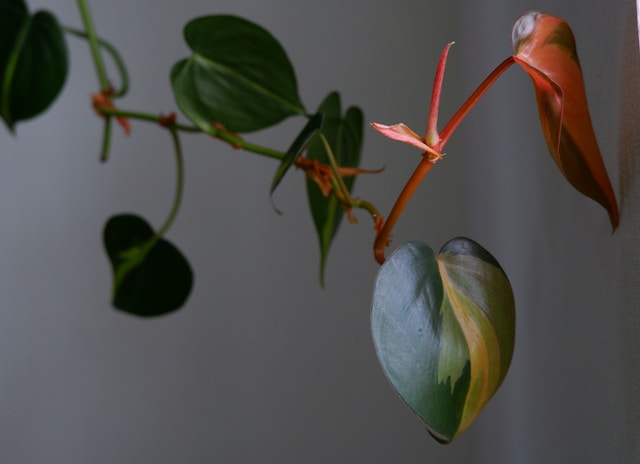
3 thoughts on “Pink Princess Philodendron”